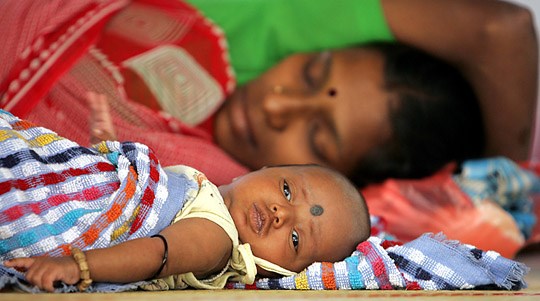Increased number of births in clinics:
Dramatic reduction in maternal mortality rates
Historical archive
Published under: Stoltenberg's 2nd Government
Publisher: Office of the Prime Minister
Press release | No: 016-08 | Date: 06/02/2008
“It is encouraging that innovative methods can produce impressive results within a short timeframe. A new approach in India demonstrates that many women choose a safe delivery in a health clinic rather than giving birth at home,” says Norway’s Prime Minister Jens Stoltenberg.
“It is encouraging that innovative methods can produce impressive results within a short timeframe. A new approach in India demonstrates that many women choose a safe delivery in a health clinic rather than giving birth at home,” says Norway’s Prime Minister Jens Stoltenberg. Preliminary numbers show that this leads to a reduction in maternal deaths by nearly a half among poor women. These measures will be promoted by Norway in other countries as well.
“Every third second a child dies and every minute a mother dies in childbirth. This is unacceptable and the world must act to change this,” Stoltenberg says.
In the Indian state of Rajasthan, Norway is cooperating with Indian health authorities on a programme paying poor women to give birth in clinics rather than at home. This has increased the number of women choosing a safe delivery in a health clinic from very few to more than fifty per cent over two years. India has spearheaded this new approach.
“These are simple measures which produce great result. It is key to spend health funds so that as many as possible can use the health facilities,” the Prime Minister says.

A young woman sleeps next to her child, Madras , Inda 2005Photo: Scanpix
This week the Norwegian Prime Minister will experience first-hand how the new approaches are being applied in India, saving the lives of mothers and babies. Projections show that by 2008 5.5 million India’s poor women will benefit from this programme.
The UN will conduct an independent analysis of this approach and the preliminary results, to evaluate the possibility of applying these methods in other countries.
During his visit to India in 2005 Mr. Stoltenberg and Indian Prime Minister Manmohan Singh agreed to cooperate on reaching the UN Millennium Goals four and five; to reduce child mortality and improve maternal health. Norway’s contribution to this programme is nearly USD 100 million over five years, directed at five states in India. These states represent sixty per cent of the country’s child mortality and the majority of Indian mothers dying in childbirth. Today 2.1 million children under the age of five die every year in India and 100,000 women die from maternal causes.
”Women die during childbirth because they are not given access to basic health services, and their children die because they are not given medicines or vaccines against simple infections. We must do more to ensure that women can give birth under safe circumstances,” says Stoltenberg.
Norway’s cooperation with India also aims at reducing child mortality. By 2009 the aim is to save half a million children annually through improved health services, and to raise the level of routine vaccination of children. The partnership will support and stimulate the accomplishment of India’s national health programme.
Result-based financing is an important tool. Resources are channelled through multilateral organisations and local institutions. Norway’s cooperation with India is part of The Global Campaign for the Health Millennium Development Goals. The global campaign consists of a number of countries, UN organisations, NGOs and institutions such as the Gates Foundation.
Prime Minister Jens Stoltenberg has said Norway over a period of ten years will grant one billion US dollars to efforts to improve maternal and child health.